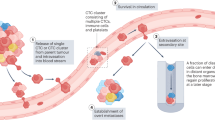Abstract.
Metastatic spread is a major factor in the prognosis of cancer patients. Early detection and eradication of circulating tumour cells prior to the development of metastases could help to improve the outcome of patients after tumour resection. Disseminated tumour cells have been detected in different compartments of the body using cytological and immunostaining methods and, more recently, using different molecular biological techniques. The most frequently studied body compartments are the bone marrow, peritoneal cavity, blood and lymph nodes, but other body fluids such as urine, bile, pancreatic juice and sputum have also been analysed. At all of these sites, tumour cells have been detected. However, the specificity and sensitivity of the methods and their prognostic impact are still being debated. This review discusses the accuracy of the detection methods and the prognostic value of detecting disseminated tumour cells in the bone marrow, blood and peritoneal lavage of patients with colorectal, gastric and pancreatic carcinomas.
Similar content being viewed by others
Author information
Authors and Affiliations
Additional information
Electronic Publication
Rights and permissions
About this article
Cite this article
Vogel, I., Kalthoff, H. Disseminated tumour cells. Virchows Arch 439, 109–117 (2001). https://doi.org/10.1007/s004280100476
Received:
Accepted:
Published:
Issue Date:
DOI: https://doi.org/10.1007/s004280100476




